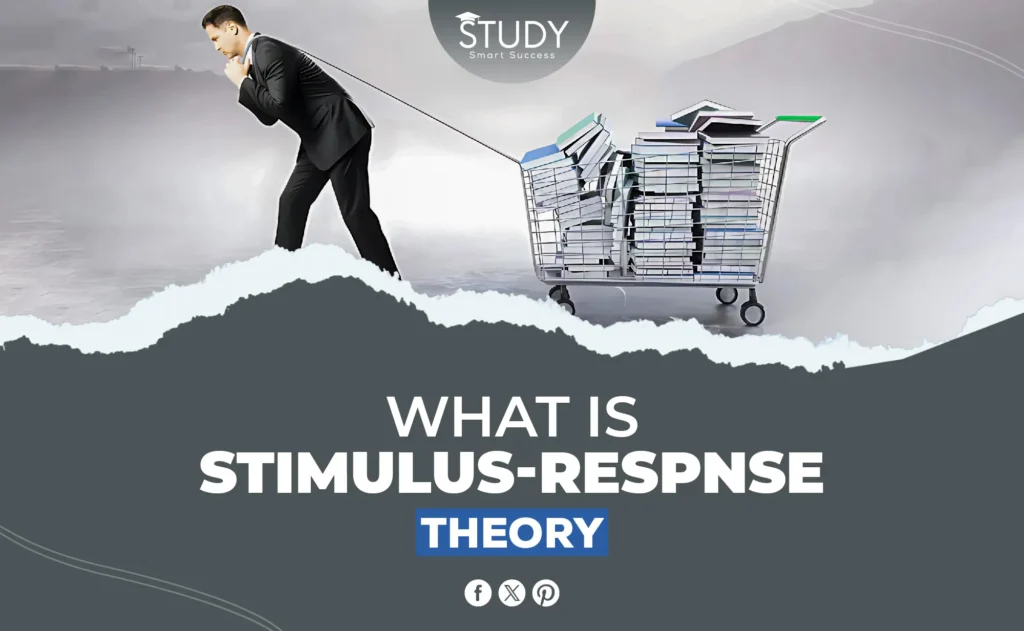Introduction to Stimulus-Response Theory
Stimulus-Response Theory is one of the most important ideas in behavioral psychology. It describes how organisms, like people, respond to certain things in their surroundings. According to this theory, every action (reaction) is caused by something happening inside or outside the person (stimulus). Knowing this idea helps you figure out why people act the way they do in different scenarios.
It is important to understand how people learn, adapt, and react to their surroundings by examining how they react to stimuli. This knowledge can be used in everyday life, psychology, education, marketing, and other areas.
Read more about developmental psychology.
Components of Stimulus-Response Theory
A few main parts of the stimulus-response theory work together to show how stimuli and reactions are related. The main parts are the following:
Stimulus
Any event, condition, or item that causes an organism to react is a stimulus. Sounds, sights, and fragrances like a ringing phone, a bright light, or a flower can be stimuli. Internal stimuli include thoughts and feelings like recalling a fond experience or preparing for a presentation. Survival and adaptation in changing circumstances require stimulus-response.
Example: When you hear a loud alarm sound (stimulus), you jump.
Response
Physiological changes, emotional emotions, and visible behaviors are responses to stimuli. Past experiences, conditioning, and genetics can dramatically affect responses. Someone conditioned to fear spiders may react significantly, like a faster heart rate or a desire to leave, whereas another may remain calm and intrigued. Psychology and behavioral science require understanding these variances to customize interventions and therapies.
Example: You quickly pull your hand away from a hot stove after touching it (reaction).
Reinforcement
Response strength depends on this. Praise, awards, and incentives encourage conduct. Maintaining desired behavior is encouraged. Negative reinforcement eliminates negative factors like stress or discomfort to correct undesirable behavior. This method promotes behavioral change and improves response patterns. Understanding these reinforcing systems improves education and workplace behavior change.
Example: If you give a dog a treat for sitting when you tell it to, it will be more likely to sit again.
Conditioning
Understanding how responses change over time requires classical and operant training. Pavlov’s dogs famously demonstrated classical conditioning by connecting a neutral stimulus with an unconditioned stimulus to produce a conditioned response. B.F. Skinner’s operant conditioning emphasizes the role of consequences in behavior modification by using rewards or punishments to modify behavior.
Example: Pavlov’s dogs learned to drool when they heard a bell because they connected it with food, an unconditioned signal.
These parts are important for understanding how stimuli are viewed and how people react. They also lay the groundwork for learning more about how people behave and interact with their surroundings.
Historical Background of Stimulus-Response Theory
The Stimulus-Response Theory emerged in the early 20th century when psychologists focused on behaviors rather than mental processes. Behaviorism stresses extrinsic stimuli and their behavioral effects. Instead of speculative mind and consciousness hypotheses, the notion allowed scientists to observe how people react to environmental signals.
The Stimulus-Response Theory is one of the most important ideas in behavioral psychology. It gives us a way to understand behavior that is measured and objective.
Researchers
Ivan Pavlov
The Russian psychologist Ivan Pavlov is an important figure in the history of stimulus-response theory. Through repeated exposure, Pavlov’s work on classical conditioning helped us understand how stimuli can be linked to reactions.
Classical Conditioning: When dogs were repeatedly shown a neutral stimulus (like a bell) and an unconditioned stimulus (like food), Pavlov’s famous experiment showed that the dogs would salivate. As time passed, the dogs started to drool at the sound of the bell by itself. This showed that responses could be learned by linking things together.
When psychologists discovered that reactions can be learned through conditioning, it changed how they thought about behavior and how we learn.
B.F. Skinner
An American scientist named B.F. Skinner built on Pavlov’s work and developed operant conditioning. While Pavlov studied automatic and reflexive reactions, Skinner investigated how consequences could change people’s free will behaviors.
Operant Conditioning: Skinner’s study used rewards and punishments to show that behaviors could be strengthened or weakened. For instance, if an action (like pulling a lever) led to a good reward (like food), it would be done again. If it led to punishment or no award, on the other hand, the behavior would probably get worse.
Skinner’s work added to the Stimulus-Response Theory by looking at more types of behaviors. It showed that people and animals could be taught to behave in certain ways using rewards.
How Their Work Shaped the Understanding of Stimulus-Response
Ivan Pavlov and B.F. Skinner made important additions to our understanding of how stimuli and responses work:
- Pavlov’s theory of classical conditioning helped us understand how environmental stimuli could teach us automatic, reflexive reactions.
- Skinner’s Operant Conditioning gave the theory more depth by showing that changing outcomes could also change people’s behaviors.
Their work is the foundation of modern behavioral psychology and stimulus-response theory in education, therapy, and marketing. Their findings show that instinct and conscious thought are not the sole elements influencing human action.
Types of Responses in Humans
People can respond to different groups based on their characteristics and methods of work. Knowing these kinds of responses is very important in areas like psychology, education, and therapy because it helps professionals adapt their methods to meet each person’s needs.
Reflexive Responses
Reflexive responses are unthinking, automatic reactions to stimuli. Rapid responses to stimuli are possible because they bypass the brain’s higher processing regions. Survival requires reflexive responses to respond to potentially dangerous situations and take preventative steps quickly. The nervous system needs them to maintain homeostasis and adjust to changing circumstances.
For Example: Blinking when something approaches or removes a hand from a scorching surface. These nervous system-controlled reflexes defend against hazardous stimuli by reacting immediately.
Voluntary Responses
A voluntary response requires conscious thought and choice. Before deciding, the brain weighs pros and drawbacks based on past experiences, social situations, and environmental clues. Cognitive contact allows people to adapt to external stimuli, facilitating personal and social progress.
For example, Raising your hand in class to answer a question is a choice that you make after thinking about it and letting other people know about it.
Conditioned Responses
Conditioned responses are learned reactions that happen through classical and operant conditioning. Over time, a person links a stimulus with a behavior or result.
For instance: Someone might start to feel anxious when they hear a certain sound that reminds them of a bad experience. This shows how associations from the past can cause emotional reactions in the present.
Emotional Responses
Emotional responses happen when stimuli combine with a person’s mood. These responses can be complicated and have many sides. They are often affected by views, experiences, and social settings.
For instance: Someone might feel happy or sad because of a certain stimulus, like a song or a memory. This shows how external stimuli and internal feelings interact.
Application of Stimulus-Response Theory
1. Behavioral Psychology
The Stimulus-Response Theory is an important part of behavioral psychology because it helps us understand how people and animals learn to behave in response to outside events. By looking at what causes a reaction, the theory lets psychologists guess how people will act in certain situations.
2. Habit Formation and Breaking
One of the most useful ways to use Stimulus-Response Theory is to figure out how habits form and how to break them. You have formed a habit when the same stimulus regularly makes you do the same thing.
3. Education and Learning
In reinforcement and conditioning instruction, stimulus-response theory is used. Teachers utilize this method to promote participation and punctuality and discourage disruption and delay. Educators attempt to create a controlled and effective learning environment by praising good behavior and correcting bad behavior.
4. Marketing and Advertising
Marketers use stimulus-response to influence consumers. They use eye-catching ads, engaging social media content, and limited-time deals to stimulate buying or brand loyalty. This method boosts sales and engagement with psychological triggers.
5. Training and Behavior in Animals
Many animal trainers employ stimulus-response theory to teach animals to respond to certain stimuli through repetition and positive reward. This method teaches dogs to sit on command and dolphins to do marine show routines.
Everyday Examples of Stimulus-Response
Reactions to Sounds
Sounds are powerful daily triggers. Hearing a loud noise sometimes makes individuals flinch or turn their heads, an innate response to danger. A phone notification might rapidly prompt someone to check their gadget, even during a discussion.
Music is another everyday example. A song can make you feel a certain way: happiness, nostalgia, or sadness. People have conditioned responses to certain songs because they link certain memories or feelings to them.
Reactions to Smells
Smell is another powerful stimulant. The smell of fresh coffee in the morning may motivate someone to make a cup. Even if you are not hungry, the fragrance of cooking can cause hunger. This reaction is generally involuntary and occurs without the individual realizing why.
Smells evoke memories for many. For instance, a perfume may remind someone of a loved one, triggering strong emotions. These responses demonstrate the strong link between smell and human behavior.
Reactions to Social Cues
Social interactions are full of behavior-guiding stimuli. People instinctively react to facial expressions, tone of voice, and body language. When someone grins at you, you often smile back without thinking.
In the same way, small social cues like nodding during a conversation can encourage the other person to keep talking, while crossed arms can show discomfort or lack of interest. These cues have a big impact on how people connect.
Criticism and Limitations of Stimulus-Response Theory
Criticisms
- Oversimplification of Human Behavior: Some say that the stimulus-response theory simplifies complicated human behavior to simple cause-and-effect relationships without considering the complexity of feelings, motivations, and thought processes.
- Neglect of Internal Cognitive Processes: The theory mostly looks at actions that can be seen and outside factors that affect people. It often forgets about the part that people’s thoughts play in how they understand and react to these factors.
- Limited Generalizability: Some critics say that results from controlled experiments might not exactly reflect what happens in the real world, making it difficult to apply the theory to all situations.
Limitations
- Context Dependence: It’s hard to correctly predict behavior because responses to stimuli can vary greatly depending on the situation. What makes someone react in a certain way in one setting might not do so in another.
- Variability Among Individuals: Because of their experiences, cultural backgrounds, and mental states, different people may react differently to the same stimulus. This shows how a one-size-fits-all method is not always effective.
- Long-Term Change: The theory’s focus on training might not fully explain the role of important life events and changes over time since behaviors can change for reasons other than stimulus-response patterns.
Conclusion
Behavioral psychology relies on Stimulus-Response Theory to describe how stimuli affect behavior. The theory’s grasp of learning, habit formation, and behavior modification benefits education, marketing, and therapy. Its focus on observable behavior provides a clear cause-and-effect framework for examining human behavior.
Stimulus-response theory is still used in psychology and daily life despite its limits in addressing internal mental processes. It helps shape and comprehend human behavior by explaining reflexes and conditioned responses. While simple, it lays the groundwork for studying more complicated psychological processes.


